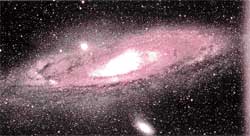A universal problem
 an understanding of the emergence of structure in the universe is one of the most perplexing problems in cosmology. The matter is complicated because of a paucity of observations of the universe at early times.
an understanding of the emergence of structure in the universe is one of the most perplexing problems in cosmology. The matter is complicated because of a paucity of observations of the universe at early times.
Among the furthest objects seen by astronomers are quasars, which are relatively small objects at high redshifts (a redshift is a measure of distance in cosmology), emitting enormous quantities of energy. A study of high redshift quasars gives us a fair idea of the state of the universe when it was relatively young. Till now, quasars have been found till a redshift of about five, which corresponds to a period when the universe was only one-tenth of its present age.
Observation of quasars in optical wavelengths indicates that their density falls steeply beyond a redshift of about three. This is heartening, because quasars are expected to be associated with galaxies and this epoch (of a redshift about three) is believed to be the era when galaxies were formed. There have, however, been doubts about the reliability of quasars' density measurements in the optical region because of the obstruction by intervening dust.
Now P A Shaver and others of the European Southern Observatory have reported a radio survey of quasars. Radio waves have an advantage over visible waves as they are not absorbed to any significant degree by the cosmic dust and hence can give us accurate indications of the number density of quasars.
The problem with this is that since only a small fraction of the quasars give out radio emissions, the sample size has to be large for reliability. The researchers worked with a sample of 878 radio sources covering about 40 per cent of the sky. They were able to identify all the radio sources as galaxies or stars with no quasars having a redshift more than five. In fact, they found that the density of quasars does indeed decrease strongly for redshifts beyond three, indicating that the optical measurements were real and not caused by absorption by dust.
If it is indeed true that there are no quasars with a redshift beyond five, then cosmologists could consider it an important time scale for the onset of galaxy formation in the universe. This will allow them to choose between competing theories of the formation of structure in the universe. With new results from the Hubble space telescope and the Keck telescope, we may be close to an understanding of the universe in its early era (Nature, Vol 384, No 6608).
Related Content
- Interconnected disaster risks: Turning over a new leaf (2025 report)
- In the hot seat: saving lives from extreme heat in Washington State
- Methodology to develop city-level, science-based, air-pollution action plans
- The role of wood residues in the transition to sustainable bioenergy
- State of Working India 2021: one year of Covid-19
- The Toxic Truth: Children’s Exposure to Lead Pollution Undermines a Generation of Future Potential
